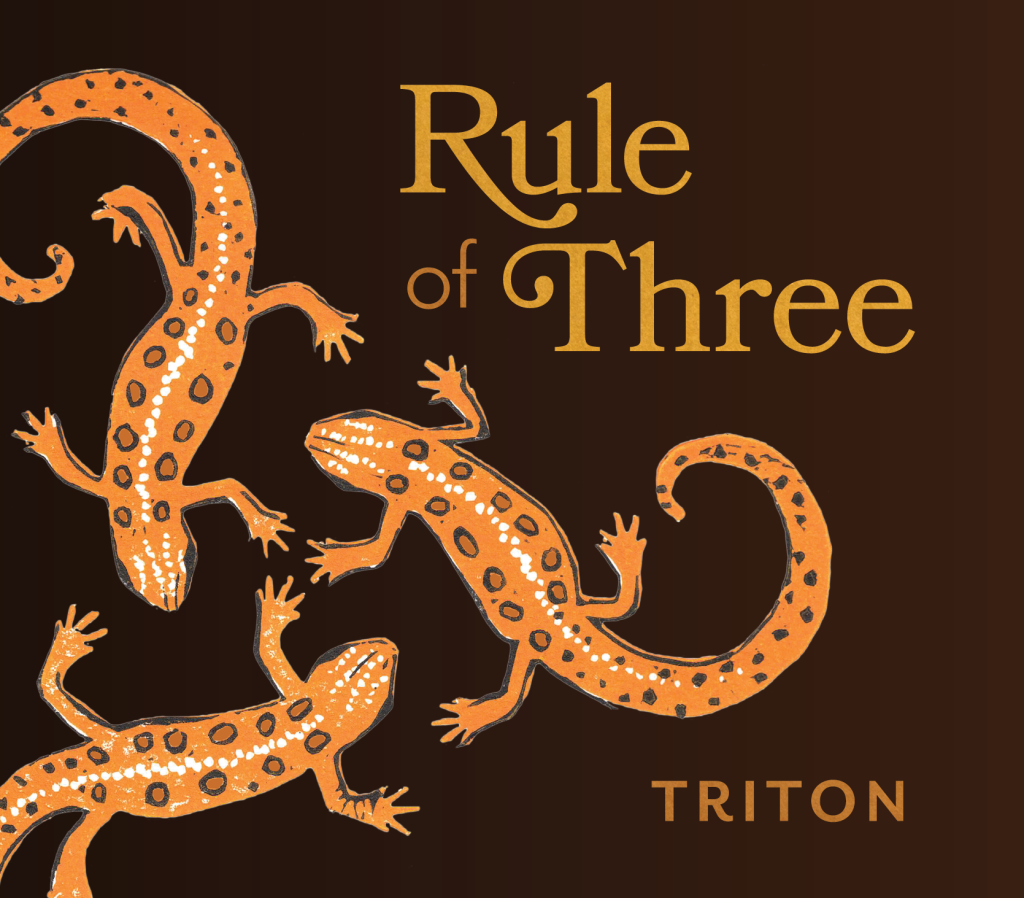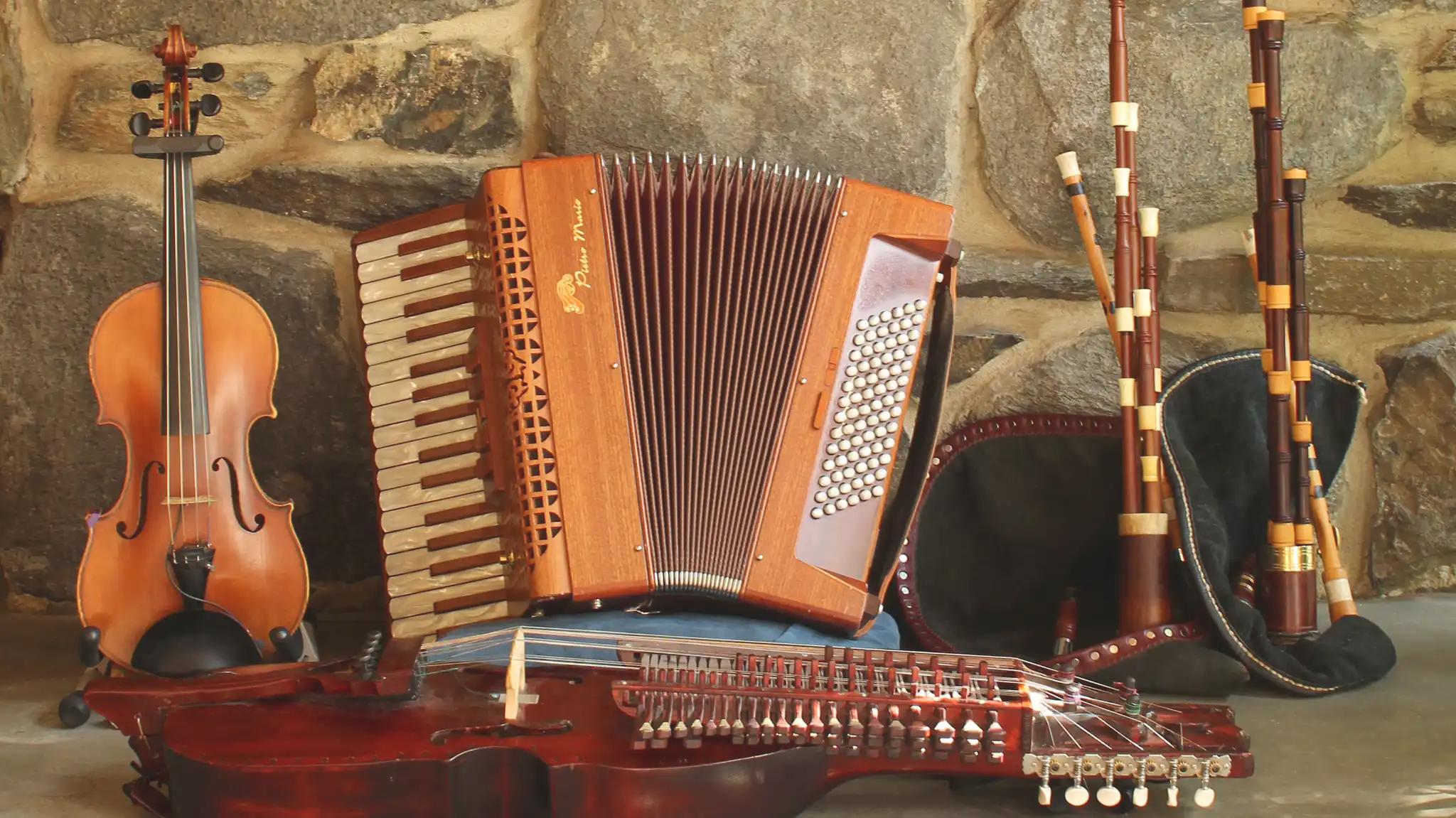
Relased in 2023 • 12 Tracks
Alex Kehler
låtmandola, nyckelharpa, violin, voice
Jeremiah McLane
accordion, piano
Timothy Cummings
pipes, whistles
with special guest
Élisabeth Giroux
voice
We are grateful, always, for the support and inspiration from our families, friends, fans, students, and fellow musicians. We are especially indebted to Steve Brittain for his passion for music and his great generosity, making all this possible; to Jeremy Mendicino for his unwavering patience and creative input (and to Roxy, the perfect studio mascot); to Donna & John Hopkins and Susan Reid for their continued support over the years and for providing central rehearsal destinations; to Mary Wesley for her collaboration, artistic support, and counsel; to Lane Gibson for his warmth, expertise, and for providing a top tier studio; and to Grey Larsen, Nate Banton, Dana Dwinell-Yardley, Eliza West, Gilbert Hervieux, Sophianne Fillion, Annemieke McLane, Michel Esbelin, Ludovic Rio, Gwenael Kivijer, Christine Bellec, Jeffrey Pierce, and Les Siffleurs de nuit.
In memory of David Surette and Pete Sutherland who have, in ways both tangible and intangible, left their marks on this album.
Track listing
- La Crouzade – 4:54
- The Shârpe Sea – 3:34
- « Les Filles des forges » – 3:15
- Le Petit rongeur – 4:05
- Gavotenn – 5:14
- Dans un pré – 5:25
- Pilé-menu – 4:52
- « Dans la froidure » – 2:58
- The Creek Beneath the Snow – 4:44
- pANDROmique – 4:08
- Grind Hans – 4:02
- « Derrière chez nous » – 3:19
- Ronds de Saint-Vincent – 3:29
- Comfort, comfort – 4:27
Notes
1. La Crouzade – bourrées 3 temps
Bourrée de Beaupuy (J-M.Delaunay) • Bourrée d’Alfred Mouret (trad. Auvergne) • La Crouzade (trad. Auvergne)
Bourrée de Beaupuy comes to us via Duo Artense’s Sur le Vif. La Crouzade is a three-part bourrée, and is unusual because it has a specific choreography that involves two couples: the man locks his left arm to to the other man’s shoulder while twirling, and they each lift the woman in their right arms, having the effect of flying their partner around in a circle! Alex learned this bourrée in Québec from a fiddle player who picked it up in Catalonia.
AK: nyckelharpa • TC: Border pipes • JM: accordion
2. The Shârpe Sea – reels
Dancing on the Bridge (trad. Scottish) • The Brown-Haired Lass (trad. Scottish) • The Shârpe Sea (©2010 T.Cummings)
We put the Scottish back in the Scottish smallpipes in this set (with a dash of Montréal spice, perhaps), culminating with a G-Lydian tune that pipemaker Nate Banton has alternately dubbed The Robot Tune.
AK: låtmandola • TC: smallpipes (A) • JM: accordion
3. « Les Filles des forges » – ridée 6 temps
(trad. Breton)
A traditional song from the village of Paimpont in eastern Brittany that recounts an encounter between young women and an abusive priest. It is a story that very much still resonates in the #MeToo era. ‘Les filles des forges’ can be sung for the traditional Breton dance known as the ridée 6 temps.
1. Digue, ding don, don, ce sont les filles des forges Des forges de Paimpont, digue ding dondaine Des forges de Paimpont, dingue ding dondon 2. Digue, ding don, don, elles s'en vont à confesse Au curé du canton, digue ding dondaine Au curé du canton, dingue ding dondon 3. Digue, ding don, don, qu'avions-vous fait les filles Pour demander pardon, digue ding dondaine Pour demander pardon, dingue ding dondon 4. Digue, ding don, don, j'avions couru les bals Et les jolis garçons, digue ding dondaine Et les jolis garçons, dingue ding dondon 5. Digue, ding don, don, ma fille pour pénitence Nous nous embrasserons, digue ding dondaine Nous nous embrasserons, dingue ding dondon 6. Digue, ding don, don, je n'embrasse point les prêtres Mais les jolis garçons, digue ding dondaine Qu'ont du poil au menton, dingue ding dondon
The Girls of the Forges 1. Digue, ding don, don, they're the girls of the forges The forges of Paimpont, digue ding dondaine The forges of Paimpont, dingue ding dondon 2. Digue, ding don, don, they went to confessional To the parish priest, digue ding dondaine To the parish priest, dingue ding dondon 3. Digue, ding don, don, "What have you done, girls," "To ask for forgiveness?", digue ding dondaine "To ask for forgiveness?", dingue ding dondon 4. Digue, ding don, don, "I/we enjoyed the dances," "And the pretty boys", digue ding dondaine "And the pretty boys", dingue ding dondon 5. Digue, ding don, don, "My girl, for your penance," "You'll have to kiss me", digue ding dondaine "You'll have to kiss me", dingue ding dondon 6. Digue, ding don, don, "I don't kiss priests," "Just the pretty boys", digue ding dondaine "Who've got hair on their chins", dingue ding dondon
AK: voice, låtmandola • TC: whistle (alto-G), voice • JM: accordion, voice
4. Le Petit rongeur – hanter-dro
Kinda Hanter (©2017 J.McLane) • Le Petit rongeur (©2021 A.Kehler)
Two original compositions in a somewhat Breton style. Le Petit rongeur makes reference to one of our favourite songs by Les Ours du Scorff, Un peu d’çi, un peu d’ça.
AK: nyckelharpa • TC: whistles (low- & high-D) • JM: accordion
5. Gavotenn
gavottes des montagnes (trad. Breton) • gavotte de l’Aven « caresse » (trad. Breton)
A unique twist is applied to some traditional Breton gavottes des montagnes (ton simpl), with a nod to the gavotte de l’Aven « caresse », a particularly entrancing chain dance that’s been enjoying a lot of popularity in the Balfolk scene.
AK: violin, låtmandola • TC: smallpipes (D), whistle (alto-F) • JM: accordion
6. Dans un pré – scottishes
Dans un pré (trad. Auvergne) • Cumul (©Patrice Corbel)
This set begins and ends with a scottish from Auvergne, first in G-Mixolydian, later in G-Major. The second tune, Cumul, we learned from flute player Christine Bellec. It was composed by Patrice Corbel, an accordionist from the Breton city of Brest.
AK: nyckelharpa • TC: smallpipes (D), whistle (high-D) • JM: accordion
7. Pilé-menu
Aux marches du Palais • untitled tune (trad. Breton, via Fleuves & Pevar Den)
Along with the hanter-dro, the pilé-menu is one of the simpler, gentler, and more hypnotic dances from Brittany. When danced at larger festivals, adjacent circles of dancers are reminiscent of the ticking gears you might find in a pocket watch (or perhaps what you’d find in a Bach-it watch).
AK: låtmandola • TC: whistle (alto-G), Border pipes, piano, organ • JM: accordion
8. « Dans la froidure » – kejaj
(trad. Breton, via J-L.Baujard)
By pure happenstance, this track—the title of which translates to “In the cold”—was recorded on the coldest day of 2023, an especially bitter day when the windchill dipped down to -40˚F/C. We felt particularly eager to summon spring! (Dancers, please note that for the purposes of this specific recording, we’ve made some additional, ‘artistic’ changes to an already changeable meter.)
Dans la froidure À [dix, huit, six...] heures dans la froidure, dansons sur la terre dure; Dansons sur la terre dure, légérement; Il y a longtemps que l'hiver y dure, viens le printemps!
In the Cold At [ten, eight, six...] o’clock out in the cold, let's dance on the hard earth; Let's dance on the hard earth, lightly; It's been a long winter — come, spring!
AK: voice, nyckelharpa, violin • TC: whistles (low- & high-D), voice • JM: piano, voice
9. The Creek Beneath the Snow – 5/4 waltzes
Dahlia (©2018 J.McLane) • Ghent (©2019 A.Kehler) • The Creek Beneath the Snow (©2008 T.Cummings)
Suffice it to share an observation by our friend and colleague Corey DiMario: “Five is the new three.”
AK: nyckelharpa • TC: whistle (low-D), smallpipes (A) • JM: accordion
10. pANDROmique – an dro
pANDROmique (©2020 A.Kehler) • two untitled tunes (trad. Breton)
The first tune was composed by Alex while twiddling his thumbs alone in lockdown in his apartment in Sherbrooke. The name speaks for itself. The second is from le pays Vannetais, a region in the southeast of Brittany. And the third is also traditional, one that Alex learned from the playing of François-Xavier Dueymes, a brilliant Breton flute player living in Montréal.
AK: nyckelharpa • TC: whistle (high-D), smallpipes (D) • JM: accordion
11. Grind Hans– jässpôdspolska
(trad. Swedish, via E.Björling)
A Swedish polska from Rättvik, in the region of Dalarna that Alex learned from his friend and colleague Emma Björling. It’s in the key of ‘Christmas Major’ (Jul dur), although it isn’t a Christmas tune per se.)
AK: nyckelharpa, violin • TC: whistles (low- & high-D) • JM: accordion
12. « Derrière chez nous »
(trad. French, via Y.Guilloux’s Anthologie de la chanson française – chansons à danser)
We’re especially grateful for the participation of, and beautiful additions by, Élisabeth Giroux, of the Québec-based trio, É.T.É.
Derrière chez nous (*English translation further below) 1. Derrière chez nous le rossignol y chante; Nuit et le jour il s'entretient d'amour, En répétant dans son charmant langage: Les amoureux sont malheureux toujours. 2. J’ai du chagrin, j’ai perdu ma maîtresse; J’ai du chagrin, j’ai perdu mes amours. Chère beauté, quand je pleure et soupire, Viens dans mes bras m’y porter du secours. 3. Quelles secours tu veux je t’y donne; S’il faut mon sang, il est prêt à couler. Mais si maman veut consoler tes peines, Demain, amour, il ne faut plus en parler. 4. Fais mon paquet, ma charmante mignonne, Fais mon paquet, car je veux m’en aller: Je partirai vers un lieu solitaire, Finir mes jours à l’ombre d’un rocher. 5. Sur ce rocher, il y’a une montagne; Moi, mon amant, nous la montons souvent. En la montant, oh ! j’ai bien de la peine, En descendant bien du soulagement. 6. Après ma mort tu pleuras, je jure Tu pleuras dans ton coeur inconstant, Tu marcheras dessus ma sépulture, En regrettant le plus doux des amants. 7. Je ne veux pas d'un sinistre carnage, Mais d'un amant qui soit sage et discret. Quand un garçon a eu quelque avantage, Ne doit-il pas en garder le secret ?
*English translation: Behind Our House 1. Behind our house the nightingale sings; Night and day he talks of love, Repeating in his charming language: Lovers are always unhappy. 2. I am sorrowed, I have lost my mistress; I am grieving, I have lost my loves. Dear beauty, when I cry and sigh, Come into my arms to deliver me. 3. What help you want, I give to you; If my blood is needed, it is ready to flow. But if mother wants to console your sorrows, Tomorrow, love, we must not talk about it anymore. 4. Pack my bag, my charming sweet, Pack my bag, because I want to leave: I will go to a lonely place, To end my days in the shade of a rock. 5. On this rock there is a mountain; I, and my lover, we often ascend it. Climbing it, oh! It takes much effort, Coming down, I am well relieved. 6. After I die you shall weep, I swear; You shall weep in your fickle heart, You shall walk over my grave, Lamenting the sweetest of lovers. 7. I don't want such carnage, But a lover who is wise and discreet. When a boy has had some advantage, Shouldn't he keep it a secret?
AK: voice, låtmandola • TC: whistles (low- & high-D), smallpipes (C) • JM: piano
Élisabeth Giroux: voice
13. Ronds de Saint-Vincent
À 10 heures sur ces landes, le rossignol y chante (G.Hervieux) • Je n’avais pas 10 ans que je pêchais l’anguille (G.Hervieux) • untitled tune (trad. Breton)
We enjoy a brisk tempo in this set, and also attempt to channel some ‘swaggery’ here — the apt descriptor that Triton’s frequent collaboratrice, Mary Wesley, suggests when teaching the rond de Saint-Vincent at Balfolk and fest-noz workshops. The first two tunes were composed by Gilbert Hervieux, and the third we gleaned from Christine Bellec.
AK: violin, låtmandola • TC: Border pipes • JM: accordion
14. Comfort, comfort – carol, 3/2 hornpipe
“Comfort, comfort ye my people” (attr. L.Bourgeois & C.Goudimel, 1551) • Rusty Gulley (trad. Lowland & Borders)
‘Comfort, comfort ye my people’ [GENEVAN 42] is an Advent carol found in many hymnals, yet remains unfamiliar to many church goers. Our choice of tempo honors the earliest use of the word ‘carol’, which referred to dancing—specifically sung dances, independent of anything religious—and may be of French or Breton origin. The triple-time hornpipe that follows comes from the Lowland & Border tradition. Its title refers to a large, multipurpose knife traditionally used in household kitchens, as well as by sailors (kitchen-forward sailors in particular).
AK: violin • TC: smallpipes (A) • JM: accordion
* all tracks arranged by Triton except for « Les Filles des forges », arranged by Les Siffleurs de nuit
Produced by Triton
Recorded May 2018 – March 2023 by Jeremy Mendicino and Lane Gibson at Lane Gibson Studios (Charlotte, Vermont, U.S.A.) and by Larry O’Malley at Audiobec (Sherbrooke, Québec, Canada)
Edited & mixed by Jeremy Mendicino
Mastered by Grey Larsen at Grey Larsen Mastering (Bloomington, Indiana, U.S.A.)
Block print artwork © 2023 Eliza West
Photography © 2023 Mary Wesley
Album design by Dana Dwinell-Yardley
Made in Vermont and Québec.
The instruments used in this recording include: Petosa, Pietro Mario, and Brandoni piano-accordions, a Yamaha C7F 7’6” grand piano and Hammond B-3 organ, a Jérôme Thibouville-Lamy violin (Joseph Kun bow), Enar Magnusson and Esbjörn Hogmark nyckelharpas (Jean-Claude Condi bow), an Ola Soderström låtmandola, as well as MK, Colin Goldie, and Michael Copeland whistles, and Scottish smallpipe and Border pipe components made by Nate Banton, Will Woodson, Hamish Moore, and Nigel Richard.
All tracks copyright © ℗ 2023 SOCAN / Birchen Music & Publishing, BMI / Floating Bridge Music, BMI. All rights reserved. Unauthorized duplication is a violation of applicable laws.

